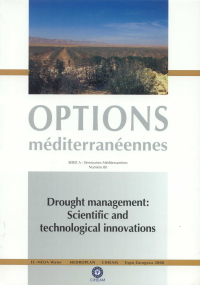| Article précédent | p. 117-122 | Article suivant |
Irrigation management of durum wheat in the Mitidja plain (Algeria): water balance models comparison and validation
In Algeria cereal crops are confronted with adverse constraints which include the irregularity of rainfall and the variability of the climate. The water remains the main factor which explains the variations of crop yields because the drought can appear at any time during the cultural cycle. Within the framework of research projects conducted in the Department of Rural Engineering of the National Agronomic Institute, two models concerning the complement irrigation were tested on cereals over the Mitidja plain in the experimental station at the National Institute Agronomy (Algiers). The experimental station is located under a Mediterranean climate. The trials were realized with a durum wheat culture variety Vitron during three campaigns 1999/2000, 2000/2001 and 2001/2002 with devices including differentiated irrigation regimes. The main objective of these experiments was to validate two water budget simulation models, Bilhyna (INRA, Paris, France) and Pilote (CEMAGREF, Montpellier, France). The main difference of these two models is that Bilhyna includes the estimation of deep water fluxes by means of finite difference resolution of the Richard's equation while Pilote uses the principle of reservoirs limited by the maximum root depth.
En Algérie la céréaliculture est confrontée à diverses contraintes dont notamment l'irrégularité des pluies et la variabilité du climat. L'eau reste tout de même le facteur limitant qui explique pour une bonne partie les variations des rendements. Une des causes des chutes des rendements reste l'effet de la sécheresse qui peut apparaître à tout moment au cours du cycle de la culture. Dans le cadre de projets de recherche menés au département du Génie Rural de l'Institut National Agronomique - laboratoire pour la maîtrise de l'eau en agriculture - nous avons testé deux modèles de gestion de l'irrigation de complément sur céréales au niveau de la Mitidja à la station expérimentale de l'Institut National Agronomique d'El Harrach. La station expérimentale est caractérisée par un climat méditerranéen. Les essais ont été réalisés sur la culture de blé dur variété Vitron durant les campagnes de 2000 à 2002 avec des dispositifs comprenant des régimes d'irrigation différenciés afin de valider les modèles de simulation avec des situations variées. Ainsi, nous avons utilisé les modèles de simulation Bilhyna et Pilote, respectivement élaborés par l'INRA France et le CEMAGREF de Montpellier (France). Le modèle Bilhyna permet d'estimer les flux profonds à l'aide de la résolution par différences finies de l'équation de Richards. Le modèle Pilote est basé sur le principe des modèles de gestion du réservoir sol multicouches.
- [ Afficher ]
- [ Télécharger ]
- [ Exporter la citation ]
Vous pouvez télécharger la citation au format :
- [ Imprimer ]
-
Mots-clés
ALGERIE, BLE DUR, COMPOSANTE DE RENDEMENT, EXPERIMENTATION, GESTION DES EAUX, IRRIGATION DE COMPLEMENT, MODELE DE SIMULATION, PLUIE, SECHERESSECiter cet article
Leulmi S., Sellam F. Irrigation management of durum wheat in the Mitidja plain (Algeria): water balance models comparison and validation. In : López-Francos A. (ed.). Drought management: scientific and technological innovations. Zaragoza : CIHEAM, 2008. p. 117-122. (Options Méditerranéennes : Série A. Séminaires Méditerranéens; n. 80). 1. International Conference Drought Management: Scientific and Technological Innovations, 2008/06/12-14, Zaragoza (Spain). http://om.ciheam.org/om/pdf/a80/00800430.pdf



